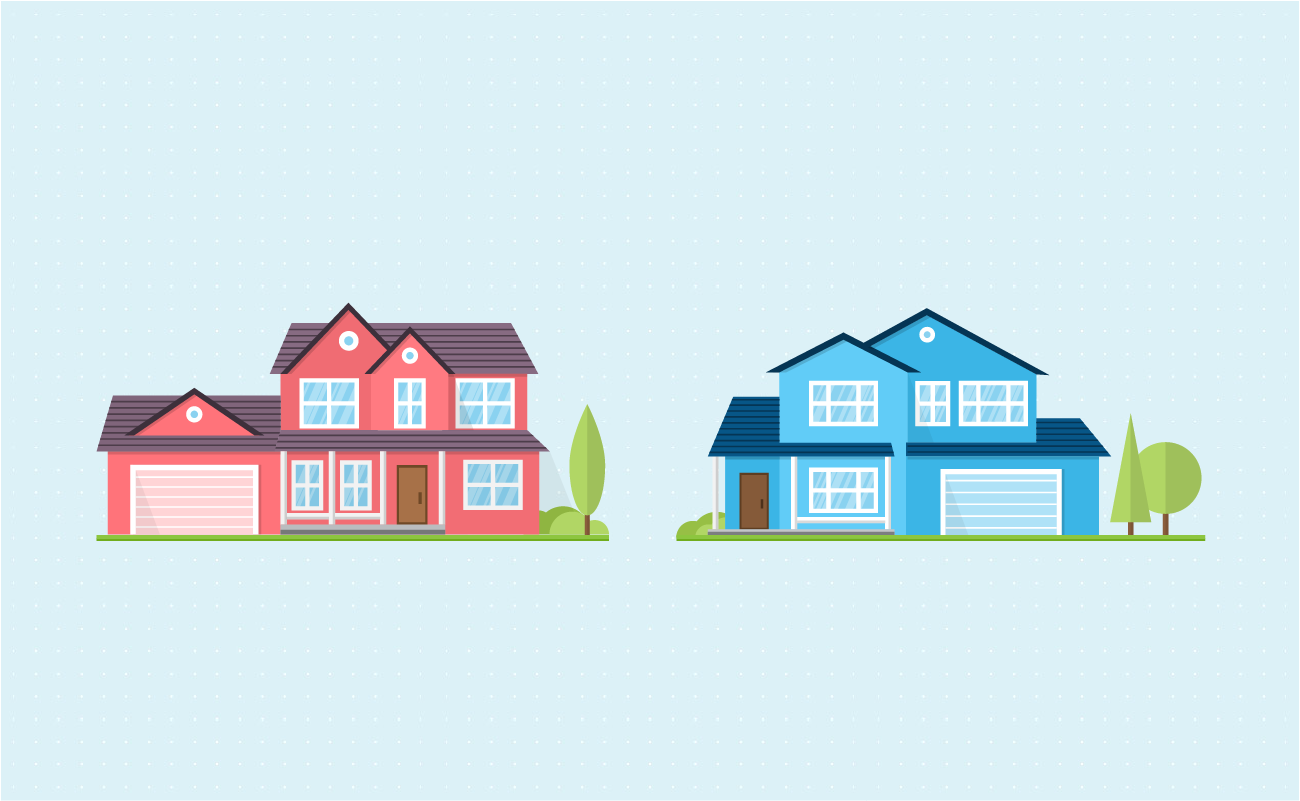Fixed Rates
30 yr
25 yr
20 yr
15 yr
10 yr
Compare Terms
Compare Rates
Real APR
Adjustable Rates
Qualification
Affordability
Renter Affordability
Rent vs Buy
Price per Square Foot
Jumbo
Home Sellers
 ARM Mortgage Payment Calculator
ARM Mortgage Payment CalculatorThis calculator helps home buyers explore what their initial monthly loan payments will be on an ARM loan and how those payments may change over time as market conditions change.
Guide published by Jose Abuyuan on OCtober 14, 2020

Before purchasing a house, borrowers must first decide between choosing a fixed-rate loan or an adjustable-rate mortgage (ARM). For most homebuyers, a fixed-rate mortgage is the safe option. Many consumers are drawn to it because of the locked interest rate, which guarantees your monthly payments remain within an affordable range.
But before you disregard ARMs, it’s important to understand how this type of loan works. In certain situations, such as eventually moving after a couple of years, choosing an ARM might work in your favor. Moreover, if you’re planning to obtain a jumbo loan, it’s worth considering an ARM over a fixed-rate loan.
Our guide will discuss how ARMs work, as well as the difference between traditional ARMs and hybrid ARMs. We’ll also explain different components of ARMs such as the index rate, margin, rate caps, and how they affect your mortgage payments. By knowing the benefits and drawbacks of ARMs, we hope to help you decide if this option is right for you.
In contrast, fixed-rate loans come with an interest rate that does not change for the entire term. These are more popular mortgage options that are usually taken as 30-year and 15-year terms. The fixed rate guarantees that your monthly principal and interest (P&I) payments remain the same for the entire payment duration. Thus, you do not have to worry about increasing payments.
Data from the Urban Institute reports that ARMs accounted for 1.8 percent of new mortgage originations in June 2020. Meanwhile, 30-year fixed-rate mortgages remain the most used mortgage product, accounting for 74.4 percent of new loans in June 2020. This is followed by 15-year fixed mortgages at 16.4 percent, which were mostly refinances.

ARMs usually begin with a lower initial rate than fixed-rate loans. Borrowers who choose this option can benefit from making affordable monthly payments during the introductory phase. However, once this initial teaser period ends, expect rates to change. When index rates reset higher, it results in higher monthly payments. Likewise, lower rates result in lower monthly payments.
ARMs are suitable for homebuyers who will not stay long-term in a home. If you plan to move and sell your house in the next 6 or so years, an ARM might be more appropriate than a fixed-rate loan. Some people buy a starter home, and eventually purchase a larger house when their family grows. Consider this when you’re planning your mortgage.
For example, a 7/1 ARM will enable you to make more affordable monthly payments during the introductory phase. On the other hand, taking a fixed-rate loan with a higher rate will have more expensive monthly payments. Do you really want to pay more for a temporary home? If you’re going to move in the near future, it’s worth choosing an ARM. For this reason, house flippers also take advantage of ARMs for the low rate before selling a home.
Moreover, many borrowers with jumbo mortgages take ARMs over fixed-rate loans. A jumbo mortgage is a type of conventional financing that exceeds loan limits set by the Federal Housing Finance Agency. It’s used by borrowers to purchase expensive homes, especially in high-cost areas. The low introductory rate on ARMs help jumbo loan borrowers make low monthly payments on their mortgage. This is beneficial when market rates remain low. But when rates rise, many jumbo ARM borrowers eventually refinance to a fixed-rate loan to lock in a lower rate.

ARMs are also a good fit for people who expect an increase in income. If you’re due for a raise or taking a higher salary job, this will help you afford the increasing mortgage payments. Likewise, borrowers who plan to refinance their loan after a few years can also choose ARMs. You can take advantage of the low introductory rate and eventually refinance into a fixed-rate mortgage with a lower rate.
According to Experian, ARMs are a common type of subprime mortgage. This means they are available to borrowers with poor credit and limited income. If your credit score needs improvement, it might be easier to qualify for an ARM than a fixed-rate loan. And due to its initial affordability, ARMs are appealing to many borrowers, including individuals with fair to good credit ratings. Moreover, the low initial payments may allow you to qualify for a bigger loan. A higher loan amount lets you choose a larger property or relocate to a better neighborhood.
Borrowers who obtain an ARM must be ready to cover increasing payments. That said, ARMs are a very risky option for people with tight budgets. If rates continue to increase beyond affordability, you risk defaulting on your loan. To steer clear of this problem, many ARM borrowers eventually refinance into a fixed-rate loan.
The unpredictable rates make ARMs unappealing to borrowers. Rising rates can make your monthly payments unaffordable, which can severely strain your finances. Worst case scenario, this puts you at risk of foreclosure. Another serious problem you might encounter is negative amortization. This happens when your monthly payments fail to cover the loan’s interest costs. It increases your principal balance rather than reduce it gradually. When negative amortization occurs, you’ll owe more on your loan than your house is worth.

Consumers can choose from two types of ARMs: a traditional ARM or a hybrid ARM.
A traditional ARM comes with a periodically adjusting rate. The most common of this is the one-year ARM where your rate adjusts once every year. On the other hand, a hybrid ARM starts off with a fixed rate for the first couple of years. This period can last for 3, 5, 7, or 10 years. After the fixed-rate period, the interest rate adjusts annually for the remaining term.
Traditional ARMs have interest rates and monthly payments that adjust at fixed regular intervals. For many years, the most widely offered type was the one-year ARM. This adjusts your rate periodically once a year for the rest of the 30-year term. Other traditional ARM options adjust every six months, three years, or five year intervals (but note that 5-year ARMs are no longer common in recent years).
Today, the most chosen adjustable-rate loans are hybrid ARMs, also referred to as “delayed first-adjustment” ARMs. It comes with a fixed interest rate for a number of years before they adjust annually for the rest of the 30-year term. The most popular adjustable-rate mortgage is the hybrid 5/1 ARM. Lenders offer other options such as 3/1, 7/1, and 10/1 ARMs.
For instance, in a 5/1 ARM, the 5 indicates the length of the introductory period. This means your rate stays fixed for 5 years. After this introductory period, your rate will adjust annually. The 1 in 5/1 ARM refers to the rate’s frequency of adjustment, which is once a year for the rest of the 30-year term.
Hybrid ARMs are popular because they allow borrowers to decide how long they want to pay a fixed rate before the loan shifts to an ARM. In this option, the interest rate increases together with the length of the introductory period. As with term lengths, a shorter period has a lower rate, while a longer period has a higher rate because it carries more duration risk. Though the rate can sometimes be slightly higher, a 5/1 hybrid ARM usually has a lower rate than a 7/1 ARM. Likewise, a 7/1 ARM usually has a lower rate than a 10/1 ARM.
The table below shows hybrid ARM rates as of October 13, 2020:
| Loan Term | Mortgage Rates (APR) |
|---|---|
| 5/1 ARM | 4.030% |
| 7/1 ARM | 3.920% |
| 10/1 ARM | 3.970% |
The low initial rate during the introductory period enables borrowers to make affordable monthly payments. With a more manageable budget, you can make extra payments on your mortgage to pay it off faster. Of course, this is not desirable for lending institutions because they earn less interest when you prepay your loan. To discourage this practice, many lenders impose prepayment penalty on mortgages. Borrowers can avoid this by choosing a lender that does not require prepayment penalty on loans.
Ask yourself the following questions before deciding on a mortgage. If you answer yes to some of these phrases, you may benefit from taking an ARM instead of a fixed-rate loan. The following situations indicate you likely cannot hold a fixed-rate mortgage for the next 30 years. You might move to a different location, expand your house, or eventually need to refinance your mortgage.
To summarize the benefits and drawbacks of adjustable-rate mortgages, we created the table below:
| Pros | Cons |
|---|---|
| Normally comes with a lower initial rate than a fixed-rate loan. | Rates are unpredictable, eventually changes after a certain period. |
| A lower rate results in affordable payments compared to a fixed-rate mortgage. | Your rate might increase once the introductory period ends. |
| Might be easier to get approval than a fixed-rate loan, accessible to borrowers with poor credit. | Increasing rates may cause payment shock. Puts you at risk of foreclosure if you fail to make payments. |
| The low initial payments may enable you to qualify for a larger loan amount. | You may encounter negative amortization, which occurs if your payments fail to cover the loan’s interest costs. |
| If interest rates reset to a lower rate, you can make lower monthly payments. | It’s more difficult to plan your finances compared to a fixed-rate mortgage. |
Many factors affect how monthly payments increase in an adjustable-rate loan. As you can imagine, it’s more complex than computing payments for a fixed-rate mortgage. Before you choose this option, learn more about its different components below.
Index – This refers to the benchmark interest rate that reflects general market conditions. Lenders refer to many indexes to determine mortgage rates. ARM interest rates change depending on the performance of a referenced index and your loan’s margin. When you choose an ARM, your lender decides which index your loan will be based on. Once the reference index is set, you cannot change it after closing.
The following indexes are commonly used to compute mortgage rates:

When interest rates are falling, primary indexes such as CMT are more favorable for borrowers. But when rates increase, it’s more advantageous to have your mortgage indexed against a lagging index such as COFI. Moreover, LIBOR, which is a commonly used index, will soon be phased out sometime after 2021. To take its place, many lenders have started using SOFR for ARM rates.
Margin – An ARM margin is added to the referenced index rate to derive the fully indexed interest rate you must pay on your loan. It’s basically the number of percentage points added to your initial rate once the introductory period ends. Borrowers with high credit scores are usually assigned a lower ARM margin, which means a lower overall interest rate for the loan. On the other hand, lower credit score borrowers are usually given a higher ARM margin, which makes the loan more costly. Again, once your margin has been set, you cannot change it after closing.
Rate Adjustment Frequency – This indicates the frequency at which the interest rate on your ARM resets after the introductory period ends. The more frequently your rate adjusts, the higher the interest costs over the life of the loan. ARM rates typically adjust once a year. But depending on your loan, some ARMs may adjust every 6 months or every month. Generally, a wider period between rate adjustments is more favorable for borrowers. To calculate your new rate on the reset date, you lender adds the margin to the index value, which then applies to the next reset date.
Rate Caps – Rate caps limit how much your interest rate can increase over the life of the loan. Two separate lenders may start with the same initial rate, but they may assign different rate caps. A higher cap means your interest rate can get higher, which makes payments more costly. It’s important to know your rate caps so you can estimate how much extra money you need to cover rising payments. Likewise, you can ask your lender for the maximum payment amount based on your rate cap.
There are three main types of rate caps:
1
Initial adjustment cap – This cap limits how much your rate can increase the first time it adjusts, which is after the introductory period. The initial adjustment cap is usually around 2 to 5 percent higher than the initial rate.
2
Subsequent adjustment cap – Refers to how high your rate can adjust in the adjustment periods that follow, which is commonly around 2 percent above the initial rate.
3
Lifetime adjustment cap – This is the maximum interest rate allowed on your ARM. It basically limits how much your rate can increase over the life of the loan. This is typically around 5 percent above the initial rate, but other lenders may impose a higher lifetime adjustment cap.
Because ARMs factor in many variables, determining monthly payments are more complicated than fixed-rate loans. But to make things easier, you can use our calculator on top to estimate your ARM payments. To understand how this works, let’s take the example below.
Suppose you’re buying a house priced at $300,000 and you’re taking a 5/1 ARM. To bypass private mortgage insurance, you make a 20 percent down payment worth $60,000. Let’s say your beginning rate for the first 5 years is 3.75 percent. Your expected initial adjustment rate is 1.25 percent, while the subsequent adjustment rate is 0.25 percent. Finally, your lifetime adjustment cap is set at 8 percent. See the table below.
Home price: $300,000
Down payment: $60,000
Loan amount: $240,000
Beginning rate (APR): 3.75%
Expected initial adjustment: 1.25%
Expected subsequent adjustment: 0.25%
Lifetime rate cap: 8%
| Loan Details | Amount |
|---|---|
| Beginning monthly P&I payments | $1,111.48 |
| Maximum monthly P&I payments | $1,581.34 |
| Total interest | $277,791.44 |
Based on the table, your monthly P&I payments will $1,111.48 for the first 5 years of your ARM. When your rate increases, your maximum P&I payment will be $1,581.34. This means you must set aside extra $469.86 to make sure you can cover your monthly payments for the rest of the term. Finally, your total interest cost can reach up to $277,791.44.
Now, what if your rate caps are higher? Let’s say everything is same, but your expected initial adjustment rate is 2 percent, and your subsequent adjustment rate is 0.5 percent. Your lifetimes rate cap is also higher at 10 percent. Let’s see the results below.
Home price: $300,000
Down payment: $60,000
Loan amount: $240,000
Beginning rate (APR): 3.75%
Expected initial adjustment: 2%
Expected subsequent adjustment: 0.50%
Lifetime rate cap: 10%
| Loan Details | Amount |
|---|---|
| Beginning monthly P&I payments | $1,111.48 |
| Maximum monthly P&I payments | $1,878.01 |
| Total interest | $361,103.10 |
Based on the table, your monthly P&I payment will also be $1,111.48 for the first 5 years. Since it’s the same beginning rate, you’ll have the same monthly P&I payments during the introductory period as example A. However, because your rate caps are slightly higher in example B, your maximum monthly P&I payment will be $1,878.01. This is higher by $296.67 than the maximum payment for example A. To make sure you can cover monthly mortgage payments for the entire term, you must set aside extra $766.53.
Finally, because your lifetime rate cap is 10 percent, the total interest cost for example B will be $361,103.10. This means you’ll spend $83,311.66 more on interest if you choose example B. To maximize your interest savings, try to obtain an ARM with lower rate caps.
Comparing example A and B shows that higher rate caps mean your monthly payments can get more expensive over the life of the loan. That said, make sure to shop for ARM lenders and compare rate caps. To qualify for lower rates, it’s best to improve your credit score before applying for a loan. The lower your rate cap, the less you have to worry about higher monthly payments.

Though fixed-rate loans are more popular than adjustable-rate mortgages (ARM), it’s important to understand when to consider an ARM.
ARMs are a good fit for people who are planning to stay in a home for just a couple of years. This includes homebuyers who need to relocate because of work, and families who eventually move to a larger house. The low initial rate can help you make affordable monthly payments during the introductory period. ARMs are also commonly used by jumbo mortgage borrowers for the affordable initial payments.
With an ARM, your rate adjusts after the introductory period ends. You can plan your move and sell your house before this time. This way, you don’t have to deal with expensive payments in case rates increase higher.
Once rates adjust, which is typically once every year, borrowers must be ready to cover increasing payments throughout the life of the loan. If rates continue to increase, this can make your payments unaffordable. Before you choose an ARM, make sure you can afford the maximum monthly payment. Try to find a lender that also offers low rate caps to make your payments more manageable.
Finally, to remove increasing payments, many ARM borrowers eventually refinance into a fixed-rate loan. This allows them to lock in a low rate and save on total interest costs. Before taking an ARM, think about whether you’ll eventually refinance your mortgage or sell your home.
Need to estimate the effective interest rate on your adjustable-rate mortgage? Use our ARM APR calculator.
Jose Abuyuan is a web content writer, fictionist, and digital artist hailing from Las Piñas City. He is a graduate of Communication and Media Studies at San Beda College Alabang, who took his internship in the weekly news magazine the Philippines Graphic. He has authored works professionally for over a decade.